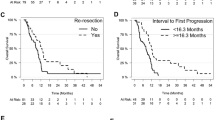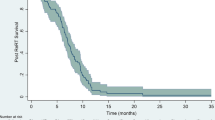Abstract
Purpose
Purpose of this study was to investigate outcome and toxicity of re-irradiation for recurrent primary glioblastoma (rGBM). We evaluated a group of patients with rGBM and identical primary treatment comprising adjuvant radiotherapy (30 × 2 Gy) with concurrent temozolomide (TMZ).
Methods
In this retrospective study of 46 patients, all received adjuvant or definitive normofractionated radiotherapy to a pretreated area, some with concurrent chemotherapy. Impact of different clinical, histological, or epidemiological factors on survival and radiation toxicity was reviewed.
Results
Of 46 patients, 40 completed the intended therapy. Overall survival (OS) was 20 months (range 6–72 months). Overall survival and progression-free survival after re-irradiation (OS2 and PFS2) were 9.5 and 3.4 months (range 2–40 and 0.7–44 months). Simultaneous systemic therapy improved PFS2 and OS2 (4.3 vs. 2.0, p < 0.001 and 12 vs. 4 months, p = 0.13, respectively). Therapy with TMZ or bevacizumab improved PFS2 vs. nitrosureas (6.6 vs. 2.9, p = 0.03 and 5.1 vs. 2.9 months, p = 0.035, respectively). TMZ also improved PFS2 and OS2 vs. all other systemic therapies (6.6 vs. 4, p < 0.001 and 17 vs. 10 months, p = 0.1). In a subgroup analysis for patients with methylation of the MGMT promoter, doses of >36 Gy as well as TMZ vs. no systemic therapy improved PFS2 (p = 0.045 and p = 0.03, respectively). 27.5% of all patients had no acute toxicity. Three patients with acute and four patients with late grade 3 toxicities were reported.
Conclusion
Normofractionated radiotherapy is a feasible option for rGBM with a good toxicity profile. Simultaneously applied systemic therapy was associated with improved outcome. For MGMT promoter-methylated histology, higher radiation doses improved survival.



Similar content being viewed by others
References
Dolecek TA, Propp JM, Stroup NE, Kruchko C (2012) CBTRUS statistical report: primary brain and central nervous system tumors diagnosed in the United States in 2005–2009. Neuro Oncol 14(5):v1–49. https://doi.org/10.1093/neuonc/nos218
Laperriere N, Zuraw L, Cairncross G, Cancer Care Ontario Practice Guidelines Initiative Neuro-Oncology Disease Site Group (2002) Radiotherapy for newly diagnosed malignant glioma in adults: a systematic review. Radiother Oncol 64:259–273
Nieder C, Andratschke N, Wiedenmann N et al (2004) Radiotherapy for high-grade gliomas. Does altered fractionation improve the outcome? Strahlenther Onkol 180:401–407. https://doi.org/10.1007/s00066-004-1220-7
Hart MG, Garside R, Rogers G et al (2013) Temozolomide for high grade glioma. Cochrane Database Syst Rev 4:CD7415. https://doi.org/10.1002/14651858.CD007415.pub2
Stupp R, Mason WP, van den Bent MJ et al (2005) Radiotherapy plus concomitant and adjuvant temozolomide for glioblastoma. N Engl J Med 352:987–996. https://doi.org/10.1056/NEJMoa043330
Perry JR, Laperriere N, O’Callaghan CJ et al (2017) Short-course radiation plus temozolomide in elderly patients with glioblastoma. N Engl J Med 376:1027–1037. https://doi.org/10.1056/NEJMoa1611977
Stupp R, Hegi ME, Mason WP et al (2009) Effects of radiotherapy with concomitant and adjuvant temozolomide versus radiotherapy alone on survival in glioblastoma in a randomised phase III study: 5‑year analysis of the EORTC-NCIC trial. Lancet Oncol 10:459–466. https://doi.org/10.1016/S1470-2045(09)70025-7
Park C‑K, Kim JH, Nam D‑H et al (2013) A practical scoring system to determine whether to proceed with surgical resection in recurrent glioblastoma. Neuro Oncol 15:1096–1101. https://doi.org/10.1093/neuonc/not069
Combs SE, Thilmann C, Edler L et al (2005) Efficacy of fractionated stereotactic reirradiation in recurrent gliomas: long-term results in 172 patients treated in a single institution. J Clin Oncol 23:8863–8869. https://doi.org/10.1200/JCO.2005.03.4157
Grosu AL, Weber WA, Franz M et al (2005) Reirradiation of recurrent high-grade gliomas using amino acid PET (SPECT)/CT/MRI image fusion to determine gross tumor volume for stereotactic fractionated radiotherapy. Int J Radiat Oncol Biol Phys 63:511–519. https://doi.org/10.1016/j.ijrobp.2005.01.056
Wick W, Puduvalli VK, Chamberlain MC et al (2010) Phase III study of enzastaurin compared with lomustine in the treatment of recurrent intracranial glioblastoma. J Clin Oncol 28:1168–1174. https://doi.org/10.1200/JCO.2009.23.2595
Wick A, Pascher C, Wick W et al (2009) Rechallenge with temozolomide in patients with recurrent gliomas. J Neurol 256:734–741. https://doi.org/10.1007/s00415-009-5006-9
Weller M, Tabatabai G, Kästner B et al (2015) MGMT promoter methylation is a strong prognostic biomarker for benefit from dose-intensified temozolomide rechallenge in progressive glioblastoma: the DIRECTOR trial. Clin Cancer Res 21:2057–2064. https://doi.org/10.1158/1078-0432.CCR-14-2737
Combs SE, Edler L, Rausch R et al (2013) Generation and validation of a prognostic score to predict outcome after re-irradiation of recurrent glioma. Acta Oncol 52:147–152. https://doi.org/10.3109/0284186X.2012.692882
Barney C, Shukla G, Bhamidipati D, Palmer JD (2017) Re-irradiation for recurrent glioblastoma multiforme. Chin Clin Oncol 6:36. https://doi.org/10.21037/cco.2017.06.18
Suchorska B, Weller M, Tabatabai G et al (2016) Complete resection of contrast-enhancing tumor volume is associated with improved survival in recurrent glioblastoma-results from the DIRECTOR trial. Neuro Oncol 18:549–556. https://doi.org/10.1093/neuonc/nov326
Ryu S, Buatti JM, Morris A et al (2014) The role of radiotherapy in the management of progressive glioblastoma: a systematic review and evidence-based clinical practice guideline. J Neurooncol 118:489–499. https://doi.org/10.1007/s11060-013-1337-6
Hudes RS, Corn BW, Werner-Wasik M et al (1999) A phase I dose escalation study of hypofractionated stereotactic radiotherapy as salvage therapy for persistent or recurrent malignant glioma. Int J Radiat Oncol Biol Phys 43:293–298. https://doi.org/10.1016/S0360-3016(98)00416-7
Lawrence YR, Li XA, el Naqa I et al (2010) Radiation dose—volume effects in the brain. Int J Radiat Oncol Biol Phys 76:S20–S27. https://doi.org/10.1016/j.ijrobp.2009.02.091
Mayer R, Sminia P (2008) Reirradiation tolerance of the human brain. Int J Radiat Oncol Biol Phys 70:1350–1360. https://doi.org/10.1016/j.ijrobp.2007.08.015
Siepmann DB, Siegel A, Lewis PJ (2005) Tl-201 SPECT and F‑18 FDG PET for assessment of glioma recurrence versus radiation necrosis. Clin Nucl Med 30:199–200
Wen PY, Macdonald DR, Reardon DA et al (2010) Updated response assessment criteria for high-grade gliomas: response assessment in neuro-oncology working group. J Clin Oncol 28:1963–1972. https://doi.org/10.1200/JCO.2009.26.3541
Straube C, Scherb H, Gempt J et al (2018) Adjuvant stereotactic fractionated radiotherapy to the resection cavity in recurrent glioblastoma—the GlioCave study (NOA 17 - ARO 2016/3 - DKTK ROG trial). BMC Cancer 18:15. https://doi.org/10.1186/s12885-017-3928-7
Combs SE, Bischof M, Welzel T et al (2008) Radiochemotherapy with temozolomide as re-irradiation using high precision fractionated stereotactic radiotherapy (FSRT) in patients with recurrent gliomas. J Neurooncol 89:205–210. https://doi.org/10.1007/s11060-008-9607-4
Osman MAM (2014) Phase II trial of temozolomide and reirradiation using conformal 3D-radiotherapy in recurrent brain gliomas. Ann Transl Med 2:44. https://doi.org/10.3978/j.issn.2305-5839.2014.05.06
Scholtyssek F, Zwiener I, Schlamann A et al (2013) Reirradiation in progressive high-grade gliomas: outcome, role of concurrent chemotherapy, prognostic factors and validation of a new prognostic score with an independent patient cohort. Radiat Oncol 8:161. https://doi.org/10.1186/1748-717X-8-161
Fogh SE, Andrews DW, Glass J et al (2010) Hypofractionated stereotactic radiation therapy: an effective therapy for recurrent high-grade gliomas. J Clin Oncol 28:3048–3053. https://doi.org/10.1200/JCO.2009.25.6941
Arcicasa M, Roncadin M, Bidoli E et al (1999) Reirradiation and lomustine in patients with relapsed high-grade gliomas. Int J Radiat Oncol Biol Phys 43:789–793
Winkler F, Osswald M, Wick W (2018) Anti-angiogenics: their role in the treatment of glioblastoma. Oncol Res Treat 41:181–186. https://doi.org/10.1159/000488258
Khasraw M, Ameratunga MS, Grant R et al (2014) Antiangiogenic therapy for high-grade glioma. Cochrane Database Syst Rev 9:CD8218. https://doi.org/10.1002/14651858.CD008218.pub3
Author information
Authors and Affiliations
Corresponding author
Ethics declarations
Conflict of interest
A. Baehr, D. Trog, M. Oertel, S. Welsch, K. Kröger, O. Grauer, U. Haverkamp, and H.T. Eich declare that they have no competing interests.
Ethical standards
All procedures performed in studies involving human participants or on human tissue were in accordance with the ethical standards of the institutional and/or national research committee and with the 1975 Helsinki declaration and its later amendments or comparable ethical standards and modifications and in accordance with good clinical practice guidelines. Informed consent was obtained from all individual participants included in the study.
Rights and permissions
About this article
Cite this article
Baehr, A., Trog, D., Oertel, M. et al. Re-irradiation for recurrent glioblastoma multiforme: a critical comparison of different concepts. Strahlenther Onkol 196, 457–464 (2020). https://doi.org/10.1007/s00066-020-01585-0
Received:
Accepted:
Published:
Issue Date:
DOI: https://doi.org/10.1007/s00066-020-01585-0




